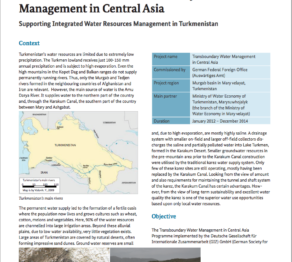
Turkmenistan’s water resources are limited due to extremely low precipitation. The Turkmen lowland receives just 100-150 mm annual precipitation and is subject to high evaporation. Even the high mountains in the Kopet Dag and Balkan ranges do not supply permanently running rivers. Thus, only the Murgab and Tedjen rivers formed in the neighbouring countries of Afghanistan and Iran are relevant. However, the main source of water is the Amu Darya River. It supplies water to the northern part of the country and, through the Karakum Canal, the southern part of the country between Mary and Ashgabat.
The permanent water supply led to the formation of a fertile oasis where the population now lives and grows cultures such as wheat, cotton, melons and vegetables. Here, 90% of the water resources are channelled into large irrigation areas. Beyond these alluvial plains, due to low water availability, very little vegetation exists. Large areas of Turkmenistan are covered by natural deserts, often forming impressive sand dunes. Ground water reserves are small and, due to high evaporation, are mostly highly saline. A drainage system with smaller on-field and larger off-field collectors discharges the saline and partially polluted water into Lake Turkmen, formed in the Karakum Desert. Smaller groundwater resources in the pre-mountain area prior to the Karakum Canal construction were utilised by the traditional karez water supply system. Only few of these karez sites are still operating, mostly having been replaced by the Karakum Canal. Looking from the view of amount and also requirements for maintaining the tunnel and shaft system of the karez, the Karakum Canal has certain advantages. However, from the view of long-term sustainability and excellent water quality the karez is one of the superior water use opportunities based upon only local water resources.
The Transboundary Water Management in Central Asia Programme implemented by the Deutsche Gesellschaft für Internationale Zusammenarbeit (GIZ) GmbH (German Society for International Cooperation) is the most extensive element of the German Federal Foreign Office’s Central Asia Water Initiative (Berlin Process). The Berlin Process supports five Central Asian states in water management and aims to establish a basis for regional cooperation in the water sector.


 Русский
Русский







